

Volume 44 Number 5
The Executive Director's Corner
ASA Annual Meeting Highlights "Christian Pioneers in Science"
"Christians are strongly over-represented" in science. That observation by MIT Prof. Ian Hutchinson gives perspective for ASA's annual meeting theme. Let's head east to check Hutchinson's claim, before we head west.
Atop the columns on the MIT campus, are inscribed the names of historic heroes of science: Copernicus, Galileo, Kepler, Boyle ... As Hutchinson and colleagues researched their lives, they estimated 60% of them were Christians - "not just nominal Christians, but deeply committed to Jesus Christ."
With that context, let's head west to observe highlights of this year's annual meeting, which was held Aug. 2-5 at Pepperdine U., Malibu, CA. This issue will concentrate on Christian pioneers on today's scientific scene who appeared personally on campus. Subsequent issues will round out the historic perspective.
General of the Genome Speaks
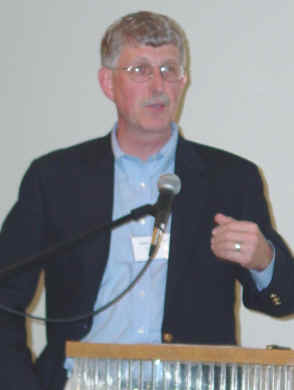 "It's been an incredible ride,
and it ain't over yet," Francis Collins said in the
exultant voice in which Archimedes must have shouted, "Eureka!"
"It's been an incredible ride,
and it ain't over yet," Francis Collins said in the
exultant voice in which Archimedes must have shouted, "Eureka!"
As Director of the National Human Genome Research Institute (NHGRI) for nine of its twelve years of existence, Collins points with satisfaction to the scientific achievements, and adds, "Here we have a federally-funded project that is ahead of schedule and under budget. Boy, does that make life easier for me!"
Collins had big shoes to fill when he succeeded Nobel laureate James Watson as the director of the National Human Genome Research Institute, and he has filled them admirably. Program Chair Sara Miles introduced him as one who always makes "unapologetic references to the spiritual nature of humanity."
He began his lecture by reading Psalm 8, in which the Psalmist says God made humans "a little lower than the angels." To illustrate the aesthetic majesty God has incorporated into humanity's DNA, Collins projected a PowerPoint slide of the Rose Window from York Minster Cathedral beside a slide looking down the barrel of DNA, "so that the double helix in its spiral form is shown in a particularly beautiful aspect." He used this visual illustration to show that the scientific and the spiritual worldviews, "which most people out there imagine are incompatible," harmonize beautifully.
About a year ago, Nature published its longest paper ever, "Initial sequencing and analysis of the human genome," ([15 February 2001]: 860-921), "some 62 pages of fine print, describing what we had learned with the first reading of a draft of the human genome sequence." Collins and a large number of colleagues spent six months preparing the manuscript. He calls it "an exhilarating experience, ... like reading the world's most incredible literature classic that no one else had ever read before, and getting to write the first critical review."
Most textbooks still carry the 15- year-old estimate that the human genome would contain about 100,000 genes. Collins said that when the inventory came out at approximately 30,000, some people felt offended. He compared that to 25,000 genes for mustard weed and 55,000 for rice, and provoked audience laughter when he said, "So you need to have more respect for dinner tonight!"
To people who think his work is done, Collins replies, "In many ways, we're at the end of the beginning." By April 2003, all the project's original goals will have been achieved.
But virtually every disease has some genetic component. "We all have probably dozens of places in our DNA where you wish you had a T but you really have a C," which makes us at risk for something. By 2010 he expects predictive tests for a dozen conditions, to map the risk factors for individuals, and to have interventions available to reduce the risk of several. By 2020 he believes the genomic therapeutic revolution will be in full swing, with gene-based designer drugs available for diabetes, Alzheimer's and several other diseases, and with gene therapy becoming the standard of care of several conditions. He says:
Where we're going next ... will have even more profound impacts on medicine and on our society. As Christians, we bring a special perspective about how to usher in this new revolution in a fashion that has the maximum benefits, and is done in the most benevolent way.
Collins' complete lecture is available in several audio formats on the ASA Website, www.asa3.org. An audiotape is available from the ASA office. Additional details regarding Collins' science and his Christian testimony are in the Jul/Aug issue of ASAN, as well as several previous issues.
MIT's Ian Hutchinson fuses "Science: Christian
& Natural"
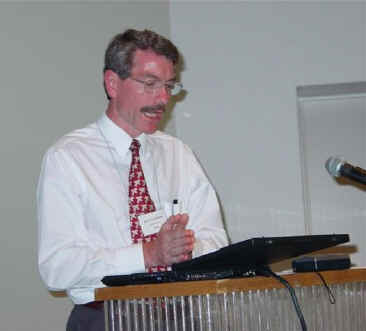 Most earthlings know three states
of matter: solid, liquid and gas. But approximately 90% of the visible universe
is in a state called plasma. If plasma can be harnessed in fusion reactions, it
will enable us to generate electricity with much less fuel, and with almost no
climate-damaging emissions such as CO2.
Most earthlings know three states
of matter: solid, liquid and gas. But approximately 90% of the visible universe
is in a state called plasma. If plasma can be harnessed in fusion reactions, it
will enable us to generate electricity with much less fuel, and with almost no
climate-damaging emissions such as CO2.
Ian Hutchinson defines fusion as "a nuclear reaction between light elements such as isotopes of hydrogen. These, when brought together sufficiently forcefully, can react and produce other light elements ... and thereby release energy." Bringing about that "sufficient force" requirement will take some doing, and for nearly his entire career, Hutchinson has been on the forefront of researching it. Currently he is Professor of Nuclear Engineering at MIT's Plasma and Fusion Center.
In his lecture entitled "Science: Christian and Natural," Hutchinson said his first exposure to Christianity had turned him off. It seemed "a vague and rather unsatisfactory sentimentality, a psychological prop that I really felt no need of, and a system of thought ... that was in the process of repudiating its own roots." In spite of having attended a school where prayers were regularly said at assembly, he remained basically ignorant of genuine Christianity.
That began changing when fellow Cambridge students invited him to a series of lectures by Michael Greene, later published as Jesus Spells Freedom. He was struck by the idea that there are strong historical reasons to believe Jesus was who he said he was, that the theological teachings of Christianity had an inner consistency that made sense of the world and of human experience and "strangest of all, that personal relationship with God was possible through Christ, entered into by faith but lived out in action in the world." He was baptized on his twentieth birthday.
Despite ridicule from friends, he sensed that his new faith and his science fused together with very little intellectual conflict. He says:
Actually the more troubling intellectual challenges I faced were ... when I was studying liberal theology and higher criticism. It seemed to me rather absurd that theology should adopt a materialistic position, ... and then after constructing elaborate stories about how the Scriptures came to be what they are, conclude that the Bible is nothing but a human book. Of course, the conclusion was ... embedded in the premises.
Hutchinson calls MIT "perhaps the high temple of technology in the U.S. and maybe even in the world." As he walks across campus, the tops of columns list the revered names of the pioneers of science. He and colleagues researched those names, and discovered that about 60% of the giants of physical science have been Christians: "Not just nominal Christians, but deeply committed to Jesus Christ."
Then where have so many people gotten the idea that Christianity conflicts with natural science? He traces it to 19th-century efforts such as Andrew Dixon White's 1898 book, A History of the Warfare of Science with Theology in Christendom. As president of the newly-founded Cornell U., White states in his preface that the book is a manifesto in support of his battle against denominational control of higher education.
Several of White's arguments turn out to lack substantive accuracy. Hutchinson elaborates this and other points on the ASA Website, in both audio and text formats.
At MIT, Hutchinson speaks freely to colleagues about his faith, prays with students struggling with personal or educational challenges, and leads seminars specifically focused on Christian content for Christians and non-Christians. (See "Coming Events" for a year-end InterVarsity seminar in which he will be involved).
He added:
But I believe that these are but the tip of the iceberg in what it means to be a Christian scientist. The marvels of the scientific world are little revelations of God's creative thoughts. They are uncovered by attention to Christian mental virtues, objectivity and truthfulness, which ... the secular scientific establishment finds to its surprise that those virtues don't necessarily come naturally to a post-Christian society. But they are part of the centuries-old heritage, built by remarkable thinkers, many of whom were devout Christians on a Christian philosophy of the world as an intelligent, intelligible, but contingent, free creation. They give opportunities for benefiting humankind - relieving hunger, need and suffering, as Jesus called us to do.
Nobelist Townes Keynotes Annual Meeting
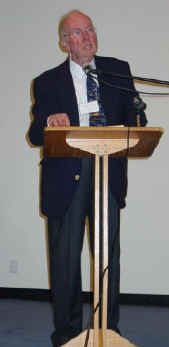 When Program Chair Ted Davis introduced
Charles Townes to the ASA annual meeting, he commented that Townes didn't act as
if he had turned 87 the previous Sunday. Still an avid diver and snorkeler, he
has an equally agile mind. For his work on the maser and laser, Townes shared
the 1964 Nobel Prize for Physics. Last year he received Russia's top award, the
Lomonosov Prize.
When Program Chair Ted Davis introduced
Charles Townes to the ASA annual meeting, he commented that Townes didn't act as
if he had turned 87 the previous Sunday. Still an avid diver and snorkeler, he
has an equally agile mind. For his work on the maser and laser, Townes shared
the 1964 Nobel Prize for Physics. Last year he received Russia's top award, the
Lomonosov Prize.
Speaking on "The Convergence of Science and Religion," Townes said both disciplines attempt to understand the universe - science concentrating on its mechanism and religion emphasizing its purpose.
The two converge by using faith, usually referred to in science as postulates. "G–del's theorem basically says ... to prove something you make a certain set of postulates; then we accept normal mathematical logic [and] ... use that logic to deduce things from those postulates and make decisions."
Both disciplines use intuition, sometimes leading to accurate conclusions, sometimes not. For example, when it was discovered that light was wave-like, intuition said it had to have a medium through which to travel in space. Scientists postulated "ether," until the Michelson-Morley experiment disproved its existence.
Revelation also plays a part in scientific discovery. After long being puzzled about the structure of benzine, Kekule saw the answer in a dream of a snake coiled around with its tail in its mouth. Townes had a similar experience: After several years of frustratedly trying to find new ways to produce radiation, a "Eureka!" moment hit him while he was sitting in the park early one morning - a key idea that later led to the maser and laser. "Where did that idea come from? ... Inspiration, revelation if you like."
The two disciplines also converge in the matter of aesthetics. "You don't know how many scientists say, 'This relation is beautiful! This must be right!'" Einstein called this property "elegance."
After the lecture, I interviewed Dr. Charles Townes and Frances, his wife of 61 years. They pray together every day and read the Bible morning and night. He says, "It makes you think about what you're trying to do," and she adds, "It gives you purpose. You greet the day as another gift from God, especially at our age."
When I asked how they remained so vigorous, he answered, "Oh, I just have a good time, ... doing things I find interesting, and I just keep doing them for fun." She added that the day before the conference, he had spent time at Mt. Wilson, digging a big hole and putting a pole in it. "It's lots of work; it isn't all glamour. But it's for a purpose." Frances' purpose for the past fourteen years has included establishing The Chaplaincy, a benevolence for homeless people in Berkeley. "That's something that feeds me," giving fulfillment.
Townes told several commencement audiences about seeming failures and sidetracks that turned to his long-term advantage. For example, when he graduated in 1939, no university research jobs were available. So he reluctantly took a job at Bell Labs, where he soon became a systems engineer. He learned new ways of viewing problems, and "much of my scientific career has grown out of that." He has the unusual distinction of belonging to both the National Academy of Sciences and the National Academy of Engineers.
Mao Tse-Tung said astronomy disproved the existence of God, and Chinese scientists had to state that they didn't believe the Big Bang theory. The year after Mao died, Townes was one of the first scientists invited to China.
Mrs. Townes says, "We think God got us together so we could interact. ... We met at a point in our lives where we were exploring what this divine part of us was, so that's been our life journey together and one of the things that has kept us together, as different as we are."
For further reading: Dr. Townes has published an earlier version of "The Convergence of Science and Religion" in his book Making Waves (Woodbury, NY: AIP Press, 1995). Among its 15 chapters are five on "Spiritual Views from a Scientific Base."
Astronomy's Ambassador to Washington
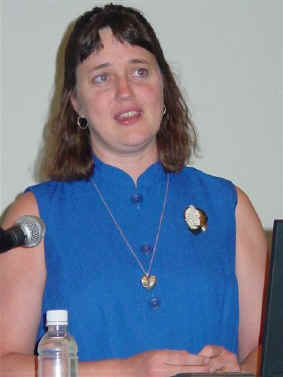 Jennifer Wiseman
had been on Capitol Hill about a week before 9/11. On that historic morning, she
was receiving orientation in the Library of Congress, directly across the street
from the Capitol, when she received news about the World Trade Center.
A CNN monitor was brought in. She recalls:
Jennifer Wiseman
had been on Capitol Hill about a week before 9/11. On that historic morning, she
was receiving orientation in the Library of Congress, directly across the street
from the Capitol, when she received news about the World Trade Center.
A CNN monitor was brought in. She recalls:
Then when the Pentagon was hit, it didn't take a brilliant mind to deduce that the big national buildings of pride were being targeted ... We didn't know how many were still to come, and we were sitting next to the most important national building that we have.
She and a terrified "fellow Fellow" went to the sidewalk and prayed, asking God's wisdom regarding the safest place to spend that day.
In retrospect, God did protect them. The plane that crashed in Pennsylvania may have been intended for them. She says, "These terrorist attacks, both by the airplane and the anthrax invasion that we had on Capitol Hill, have had a major effect on Congress and all the staff and Fellows ..."
What had brought a Ph.D. astronomer to Washington, where the lights are too bright for optical astronomy? A mix of boredom with research plus a sense of civic duty led her to ask God for some kind of change. "The Lord answered in giving me this unusual position on Capitol Hill." Jennifer's sponsor is the American Physical Society, and she serves on the Science Committee of the House of Representatives. She works mainly with the Subcommittee on Space & Aeronautics and the Subcommittee on Research. The Science Committee has oversight jurisdiction over many science agencies such as NASA and the National Science Foundation (NSF). Jennifer is responsible mainly for issues relating to space science, earth science, and astrophysics, such as NASA space-based telescopes and planetary probes and also NSF-funded ground-based astronomy and physics facilities.
Science plays a role in nearly every issue that Congress considers: basic research, national security, the economy, environment, education, etc. Yet most lawmakers have very little scientific or technical background. Exceptions to this include two physicists: ASA Fellow Vernon Ehlers (R-MI), a former Calvin C. Professor, chairs the House Science Committee's Subcommittee on Environment, Technology and Standards, and Rush Holt (D-NJ) is the former director of the Princeton Physics Laboratory. Much of the legislative work on the Hill in Member offices is actually carried out by assistants in their mid- 20s(!), though committee staffers tend to be more senior.
Capital culture shock
Washington can shock a newcomer. In
science, brilliant insights and academic discourse rule; people skills are
secondary. In Washington, however, "if you have great connections, people
skills, networking, that is tops." Another surprise is that "decisions
in the political realm are not always made solely on truth and scientific
'logic.' Or maybe there are many levels of truth" - such as tobacco
lobbyists presenting the alternative "truth" of economic impact on the
home district if tobacco subsidies are discontinued.
Jennifer observes: "The first priority of Congress has turned to national security. But what do we as a nation gain and lose by shifting the bulk of our attention to nervous self-protection?"
Wiseman believes more Christians should be involved on Capitol Hill - some as elected officials, others in support positions. She sees a need for greater discernment and for balanced discussion of issues. She is "disturbed by the way hearings are set up, bringing in witnesses who all say the same thing," such as in hearings and briefings on what is variously called embryonic stem cell research or therapeutic cloning. One side monopolizes the presentations, without even acknowledging the other side's objections. Thus the issue is never clarified "that you do have the equivalent of a fertilized egg that's dividing and growing ... [and] if it were implanted it would continue to grow. For many people that is a human life or close enough to it that it makes this research disturbing, while for others the promised medical benefits seem to hold sway. But one never gets the feeling that either side understands or acknowledges fully the concerns and viewpoints of the other."
Capitol Hill has a dual deficit - of scientific expertise and of ethical discernment. Wiseman says: "If you put all these ideas together, it would be wonderful to have more Christian scientists in government, in public policy, because then you have people who have the background and technical and scientific expertise who also have a sense of global stewardship ... Christians have an explicit calling of the Lord to do everything to his glory ... Christians with scientific backgrounds and gifts and insights are needed at all levels."
A Lifelong Quest: Tracking Copernicus
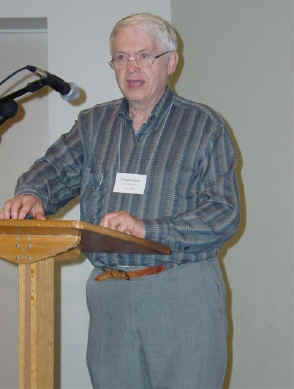 Chaos theorists think when a
butterfly flaps its wings over Kyoto, it provokes an Atlantic hurricane three
years later. If that's true, Owen Gingerich told a plenary
session, "The gentle flight of a butterfly began for me in the wee hours of
June 20, 1946," when he was a 16-year-old Merchant Marine cowboy delivering
847 horses to post-war Poland under UN Relief & Rehabilitation
Administration auspices.
Chaos theorists think when a
butterfly flaps its wings over Kyoto, it provokes an Atlantic hurricane three
years later. If that's true, Owen Gingerich told a plenary
session, "The gentle flight of a butterfly began for me in the wee hours of
June 20, 1946," when he was a 16-year-old Merchant Marine cowboy delivering
847 horses to post-war Poland under UN Relief & Rehabilitation
Administration auspices.
That was step one in a saga that included a missed flight, chance encounters and dogged determination - all leading to a lifelong worldwide quest to research 600 copies of Copernicus' De Revolutionibus Orbium Coelestium ("On the Revolutions of the Celestial Orbs"). Contradicting novelist Arthur Koestler's statement that Copernicus' tome was "the book that nobody read," Gingerich tracked down well-read copies once owned by a range of people. "But most interesting are the exemplars owned and annotated by astronomers, which illuminate the long process of acceptance of the sun-centered cosmos ... Here are also fascinating turf battles among astronomers, as well as the struggle of the Church to come to terms with the new reality."
Entitling his lecture "Forbidden Games: The Religious Reaction to the Copernican Theory," Owen debunked the common impression that the Catholic Church had universally censored De Revolutionibus. Instead, he discovered censorship was heavily concentrated in Italy. He said:
About two-thirds of the copies in Italy were censored and essentially none elsewhere ... It became apparent in looking at this, the rest of the world saw that exercise as a local Italian imbroglio, and they were having none of it. In fact, the Spanish version of the Index explicitly permitted the book.
We anticipate that this lecture will appear in a future issue of PSCF, and next year Walker Press expects to publish Gingerich's account of his Copernican quest, under the title The Book Nobody Read.
One other butterfly who stimulated Gingerich to excel to the level that he did, was the late Harold Hartzler. In his introduction, Ted Davis called Hartzler "a mover and shaker in the early ASA" and a prof. under whom Gingerich studied at Goshen C., before moving to Harvard for graduate studies. What current ASAers are mentoring students in comparable ways?
ASA Annual Meeting, Pepperdine U., Malibu, CA, August 2-5, 2002
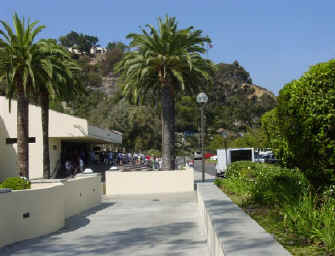
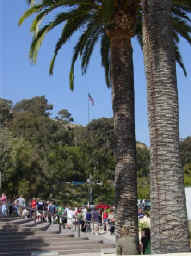
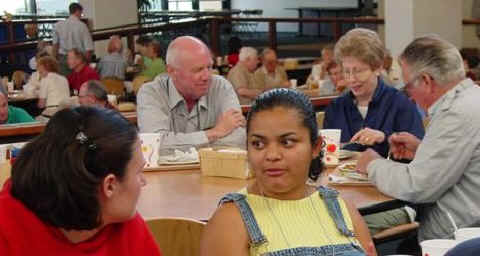
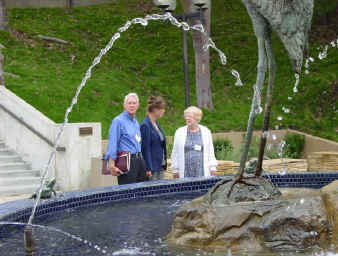
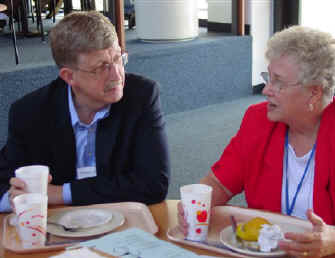
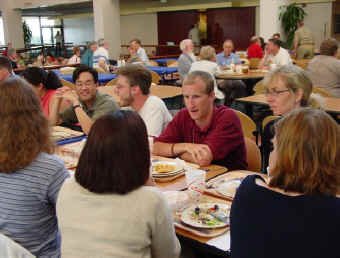
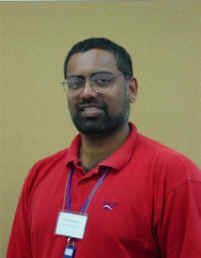
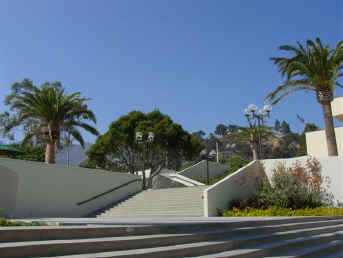
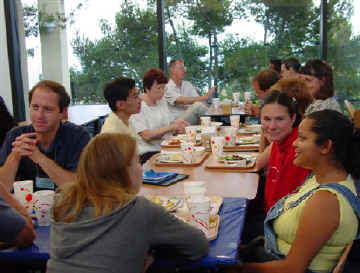

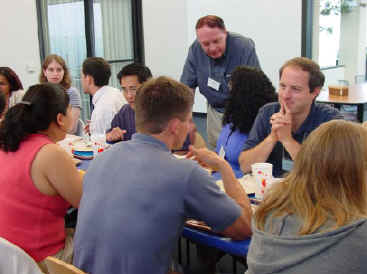
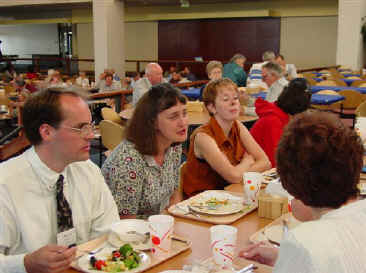
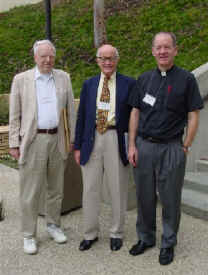
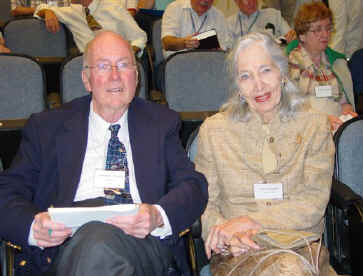
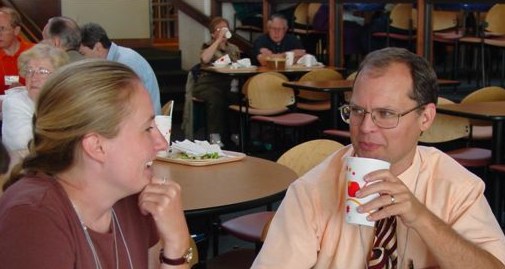
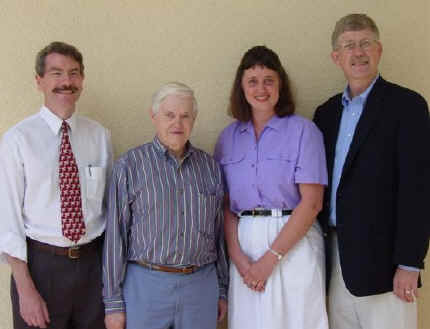
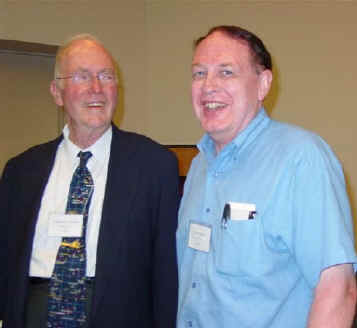
Left picture
Plenary speakers: I. Hutchinson; O. Gingerich;
J. Wiseman; F. Collins.
Right picture
Plenary speaker C. Townes;
ASA Executive Director D. Munro
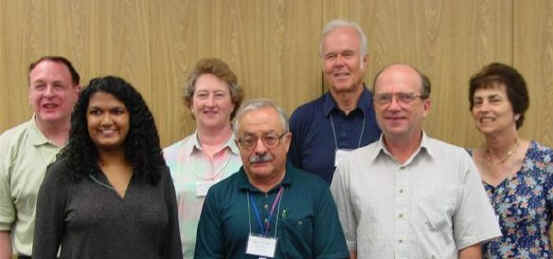
ASA Executive Council:
front row: S.
Daniels, young scientist representative;
K. Touryan; M. Price;
back row: D.
Munro; D. Chappell; F. Hickernell; M. Flora
![]()
Scholarship Winners Present Findings
Some under-30 scholarship winners
gave papers during Saturday afternoon parallel sessions. They are: Young
Astrophysicists: Kyler Kuehn, "The Search for
Astrophysical Neutrino Sources with AMANDA"; J. Brian Pitts,
"Reconciling Relativity with Tensed Time"; Young Scientists on Science
and Religion: Julia Scally, "A Look at Faith-Based
Community Organizing from the Church Perspective"; Jason Colwell,
"Chaos and Providence"; Young Biologists: Andrew Babcock,
"PCR Detection and Stain Characterization of Plasmodium falciparum in
Symptomatic Children in Zambia"; Chelsea Matsko,
"Selection and Analysis of SV40 T ag Epitope I Escape Variants"; and Kimberly
Brothers, "Improving the Technique for the Intracellular Uptake of
Bacteria Using Murine Peritoneal Phagocytes and Fluorescence Phase Contrast
Microscopy."
|
|
Kyler Kuehn , left: "The Search for Astrophysical Neutrino Sources with AMANDA"J. Brian Pitts , right: "Reconciling Relativity with Tensed Time." |
|
|
Julia Scally, left: "A Look at Faith-Based Community Organizing from the Church Perspective," Jason Colwell, right: "Chaos and Providence." |
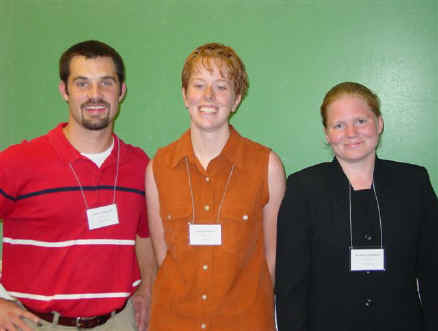
Andrew Babcock, left: "PCR Detection and Stain Characterization of Plasmodium falciparum in Symptomatic Children in Zambia,"
Chelsea Matsko, center: "Selection and Analysis of SV40 T ag Epitope I Escape Variants"
Kimberly Brothers, right: "Improving the Technique for the Intracellular Uptake of Bacteria Using Murine Peritoneal Phagocytes and Fluorescence Phase Contrast Microscopy."
Local ASA Events
Gingerich is research professor of astronomy and history of science at Harvard and senior astronomer emeritus at Smithsonian Astrophysical Observatory. He is a leading authority on 17th-century German astronomer Johannes Kepler and on Nicholas Copernicus. His talk is entitled "Galileo: Hero or Heretic?"
Newman is professor of New Testament at Biblical Theological Seminary, Hatfield, PA, and Director of the Interdisciplinary Biblical Research Institute (IBRI). He received his doctorate in theoretical astrophysics from Cornell U. His presentation is entitled "The Cosmos and the Bible: A Critical Examination of Modern Cosmological Theories."
For more information or to be put on the Eastern PA contact list, email Alan McCarrick at: admeam@aol.com
The next meeting is scheduled for Sept. 28, 2002 in Dallas, discussing bioethics. For more information, e-mail Scott Robinson: scott_at_asa@ev1.net.
Coming Events
Call for Papers
Toward a Culture of Life:
Restoring Human Felicity sponsored by Journal of Interdisciplinary
Studies (JIS), an international journal of interdisciplinary and interfaith
dialogue.
Despite spectacular scientific and technological advances at the dawn of the Third Millennium, which promise to extend life and cure many diseases, human life remains precarious, especially at inception and in old age. Can the present crisis of human worth find resolution in a culture which celebrates all life, thus restoring human felicity?
Mss. Deadline: 1 January 2003. Send 3 double-sided copies of a 15-25 page mss. +150-word abstract, typed, double-spaced, in-text citation format, author identification on a separate sheet only (SASE for mss. return) to: Dr. O. Gruenwald, JIS Editor, IIR, 1065 Pine Bluff Dr., Pasadena, CA 91107. Visit www.JIS3.org
New Editors
If you were at Pepperdine, you saw
new Newsletter editors Dave Fisher and Margaret Towne covering
the event. We'll introduce them in more detail next issue. Dave was lead editor
for this issue, Margaret will take primary responsibility for the next issue,
and they'll rotate.
Amid news of the annual meeting, they do want to squeeze in one thought:
Please submit your news and feature ideas.
To minimize the confusion, there's one central e-mail address:
If that's occasionally out of operation, contact them directly: dfisher@twr.org or TowneMG@aol.com.
Upcoming ASA Conferences
July 25-28, 2003: Colorado Christian
Univ., Lakewood, CO
July 23-26, 2004: Trinity Western Univ., Langley, BC Canada
Aug. 5-8, 2005: Messiah College, Grantham, PA
July 28-31, 2006: Calvin College, Grand Rapids, MI
New Book
Hope C. psychologist David
Myers recently published a new book, Intuition: Its Powers and
Perils. Details are at www.davidmyers.org/intuition.
Anniversary Couple
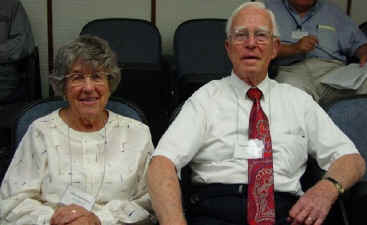
Alice and John Fredickson celebrated 56 years of marriage.
Job Postings
For descriptions of job postings,
visit the ASA web site. At press time, these included physics and environmental
advocacy.
With the Lord
Carbon scientist Jack L.
White passed away on Feb. 20, 2002 at age 76. Our present understanding
of the various microstructures formed in the carbonaceous mesophase and its
associated disclination structures stems directly from his pioneering work.
Jack earned a Ph.D. in metallurgy from UC-Berkeley. He worked as visiting scientist at EUROATOM in Holland from 1967 to 1969. In 1973, he joined the Aerospace Corporation in El Segundo, CA, as a research scientist in the Materials Science Lab. He "retired" in 1988 and joined the Chemical Engineering group at UCSD.
He is survived by his brother, Don; a daughter, Janette; and two grandsons.
Information from the professional journal Carbon
and from his daughter.
* Janette
Shelton
![]()
The Executive Director's Corner
by Donald W. Munro
What a surprise! When I went to save this latest Executive Corner file, I found that this Corner is number 50. They are all lined up but not in order since I used different abbreviations like execlet or execlt with a number after it. One time I used exectlt. That must have been a mentally off day. Can I really have written fifty? It is hard for me to believe.
The 57th annual meeting of the ASA with its 220 registrants is history. It is difficult and unfair to rank meetings but much thanks goes to Ted Davis and Sara Miles who, though busy people, put in the many hours that were necessary to assure quality and diversity to make this an outstanding meeting. Thanks again to those donors including the Templeton Foundation who made the Young Scientists' scholarships available. It bodes well for our future.
Following the meeting, Stan Moore, who served most admirably as our Local Arrangements Chair, and I plus our wives went up the California coast from Malibu to the Big Sur and spent several days in the beautiful Monterey area. My wife and I then went to Seattle, WA, to visit our daughter and family which includes our very cute 18-month-old grandson. She took us to the Olympic National Forest where we did much hiking and site seeing including a trip to see Hurricane Ridge. A few of you may remember that we were supposed to see that on our ASA field trip in 1993 from Seattle Pacific U. but somehow we never quite made it as we ran out of time. It was a magnificent site. From the top of the ridge, one can see across the Strait of Juan de Fuca to the city of Victoria.
Now let's get ready to go to Colorado Christian U. in Lakewood, CO, a suburb of Denver, July 25-28, 2003. It will emphasize astronomy and cosmology with Jennifer Wiseman as Program Chair and David Oakley as Local Arrangements Chair assisted by Ken Touryan. One featured speaker will be Dr. Dennis Danielson from the U. of British Columbia and editor of The Book of the Cosmos.
While Pepperdine is low, Colorado Christian U. is high - I'm talking altitude. You want to be high up for this topic. I still remember one of the best looks I got at the heavens with the naked eye was when we were living in Kijabe, Kenya more than 7,000 feet up. Not only do the stars appear close, but there is little ground light to hinder your vision of the southern cross and other astronomical wonders. I hope that the Colorado sky is clear for us next summer.
In this issue, we recognize those who joined ASA thirty years ago according to the membership records of our newsletter or journal. Some may have dropped out and rejoined but that information was burned up in the fire. Thus, I congratulate the following sixteen people: Kenneth B. Aring, Russell R. Camp, Juan A. Castro, Gordon E. Fish, Benjamin M. Hatch, William J. Kinnaman, Ronald L. Kotesky, Albion J. Kromminga, Richard A. Leo, Donald G. Ring, William D. Sisterson, Duane E. Stevens, Gerald van Belle, Philip R. Whitney, Robert B. Wilhelmson and Davis A. Young. Do not forget to celebrate your memories and present activities with our new newsletter editors.
Now for the final installment of the survey last February at Congress 2002 taken through a random sampling of 71 people from among those that happened to come by our booth. There are two questions left. The first is: How did God create the diversity of living things? Twenty-five said it happened by God's decree all at once in the first days of earth; twenty-one thought it was by God's decree and through small evolutionary changes; fourteen chose by God's decree at different times in earth's history; five picked the phrase, mainly through evolution once God started things; and six admitted that they did not know. The final question is: Was there a big bang at the beginning of the universe? Twenty-six said yes, twenty-three said no, and twenty- two were undecided. How is that for a split decision?
Many, many thanks to some who are helping us with the necessary and important computer upgrade at the ASA office. As many of you know, such matters seem to be never ceasing. Sometime this fall we hope to have each of the staff upgraded with a satisfactory computer. That will be wonderful. Staff has done wonders with what we have. Things are getting so fast on my new computer that I am saving time to work on other things. Unfortunately the thoughts for this column do not come any faster with an upgraded computer.
A special thanks to those of you who have already sent a donation in 2002. We are counting very heavily on your continued contributions as you renew your dues for 2003 this fall. We have calculated the yearly cost per member to be roughly around $150 so that the difference between your membership fee and this real cost is made up by sales, grants and, above all, your donations. Thus, even our Fellows only pay half their cost in dues. Because you continue to donate so freely, Council decided once again not to raise the membership dues for 2003. Your generous donations will help us keep the dues down.
![]()